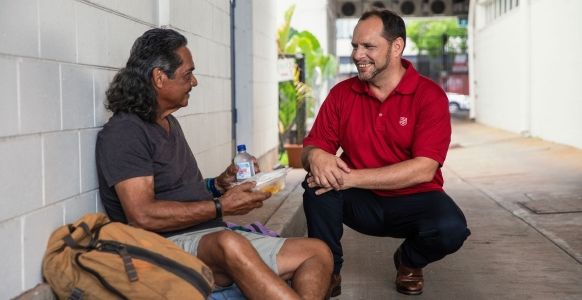Aboriginal and Torres Strait Islander homelessness statistics
How many Aboriginal and Torres Strait Islanders are experiencing homelessness?
Aboriginal and Torres Strait Islander peoples are estimated to be 3.8 per cent of the Australian population. However, they make up 20 per cent (or one in five) of the number of people experiencing homelessness in Australia.
Of the Aboriginal and Torres Strait Islander people experiencing homelessness:
- Three in five (60%) were living in ‘severely’ crowded dwellings
- Almost one in five (19%) were in supported accommodation for the homeless
- Nearly one in 10 (9%) were living in improvised dwellings, tents or sleeping out
Aboriginal and Torres Strait Islanders — connection to Country and homelessness
While the official Census numbers are staggering, they may not fully reflect how Aboriginal and Torres Strait Islander peoples see their own living situation when it comes to homelessness.
The information paper, Aboriginal and Torres Strait Islander Peoples Perspectives on Homelessness notes,
“For many Aboriginal and Torres Strait Islander people, disconnection from Country is considered a form of homelessness.”
This means many Indigenous Australians may describe themselves as ‘homeless’ because they are living off Country and are disconnected from their family and/or friends — even though they may be living in a stable and safe house.
Additionally, some Indigenous Australians may be considered as living in ‘overcrowded housing’ because they are still living with family and/or on Country.
Although there are differences in how people may perceive their housing situation, the fact is that Aboriginal and Torres Strait Islander peoples are overrepresented among those accessing Specialist Homelessness Services (SHS). The statistics show more than one quarter (28%) of the people assisted by SHS in 2023–24 identified as Indigenous, with nearly half (48%) being under the age of 25.

The Salvation Army acknowledges that responding to homelessness among Aboriginal and Torres Strait Islanders is a culturally sensitive issue and must be approached with respect. Through a wraparound approach, we work to honour and respect people’s beliefs, values and goals, working with them to achieve their desired outcomes.
Facts about Aboriginal and Torres Strait Islander peoples seeking homelessness support
The key reasons people seek assistance from SHS, like The Salvation Army, include family and domestic violence, the housing crisis and inadequate or inappropriate dwelling conditions. Statistics from the Australian Institute of Health and Welfare (AIHW) show the three most common main reasons why Aboriginal and Torres Strait Islander peoples seek assistance from SHS.
- 25 per cent — family and domestic violence
- 17 per cent — housing crisis
- 14 per cent — inadequate and inappropriate dwelling conditions
SHS take a multi-layered approach to meeting the needs of people seeking support, ensuring needs and goals are identified and addressed as best as possible.
AIHW figures show Indigenous peoples seeking support needed:
- Short-term or emergency accommodation (49%)
- Assistance for family/domestic violence (27%)
- Material aid/brokerage (37%)
- Long-term housing (38%)
Why are there more Aboriginal and Torres Strait Islander people who are homeless?
According to a report by the AIHW, the overrepresentation of Aboriginal and Torres Strait Islander peoples in Australia’s homeless population is a result of a range of previous discriminatory policies. The flow on effect means that Indigenous peoples now experience:
- Higher rates of unemployment, which means reduced financial resources to access secure and good-quality housing
- Discrimination when applying for accommodation
- Long waiting lists for public housing — particularly in remote areas
- Housing that does not meet the needs of Indigenous Australians — whether that’s inadequate bedrooms to cater to large families or poor housing facilities
- Overcrowding
Indigenous peoples also have strong family connections and cultural obligations to share resources. This extends to providing accommodation to family members — even when the home is too small to comfortably or safely do so.
Overcrowding can have negative effects on physical and mental health, such as food insecurity, a lack of privacy, reduced hygiene, increased spread of infectious diseases and a lack of quiet space for study, work and sleep. This can lead to poor mental health and education outcomes, which continues the cycle of Aboriginal and Torres Strait Islander homelessness.
Addressing homelessness among Australia’s First Nations peoples
The National Agreement on Closing the Gap has 19 targets to improve life outcomes for Aboriginal and Torres Strait Islander peoples. Number nine’s outcome is: “Aboriginal and Torres Strait Islander people secure appropriate, affordable housing that is aligned with their priorities and need.”
The Salvation Army is committed to reconciliation with Aboriginal and Torres Strait Islander peoples. Statistics show, and we recognise, that Indigenous peoples are over-represented in the population experiencing homelessness and across all our services in the community.
Our Reconciliation Action Plan outlines our priorities to address social injustices experienced by Aboriginal and Torres Strait Islander peoples in relation to:
- Poverty and financial hardship
- Homelessness and housing
- Family and domestic violence
- Substance-use disorders
Salvation Army teams work to create culturally safe services and spaces to help improve life outcomes and reduce disadvantage among Aboriginal and Torres Strait Islander peoples. Their lived experiences guide our approach to service delivery, along with best-practice statistical evidence and fact-based research.